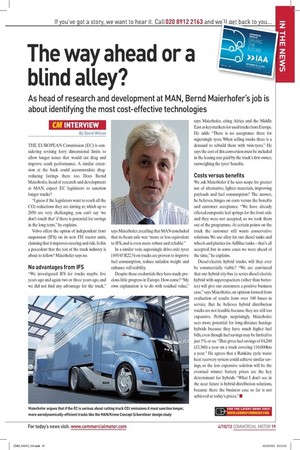The way ahead or a blind alley?
Page 13

If you've noticed an error in this article please click here to report it so we can fix it.
As head of research and development at MAN, Bernd Maierhofer’s job is about identifying the most cost-effective technologies
INTERVIEW
By David Wilcox
THE EUROPEAN Commission (EC) is considering revising lorry dimensional limits to allow longer noses that would cut drag and improve crash performance. A similar extension at the back could accommodate dragreducing fairings there too. Does Bernd Maierhofer, head of research and development at MAN, expect EC legislators to sanction longer trucks?
“I guess if the legislators want to reach all the CO2 reductions they are aiming at, which up to 2050 are very challenging, you can’t say ‘we don’t touch that’ if there is potential for savings in the long term,” he explains.
Volvo offers the option of independent front suspension (IFS) on its new FH tractor units, claiming that it improves steering and ride. Is this a precedent that the rest of the truck industry is about to follow? Maierhofer says no.
No advantages from IFS
“We investigated IFS for trucks maybe five years ago and again two or three years ago, and we did not find any advantage for the truck,” says Maierhofer, recalling that MAN concluded that its beam axle was “more or less equivalent to IFS, and is even more robust and reliable.” In a similar vein, supersingle drive-axle tyres (495/45 R22.5) on trucks are proven to improve fuel consumption, reduce unladen weight and enhance roll stability.
Despite these credentials they have made precious little progress in Europe. How come? “My own explanation is to do with residual value,” says Maierhofer, citing Africa and the Middle East as key markets for used trucks from Europe. He adds: “There is no acceptance there for supersingle tyres. When selling trucks there is a demand to rebuild them with twin-tyres.” He says the cost of this conversion must be included in the leasing rate paid by the truck’s first owner, outweighing the tyres’ benefits.
Costs versus benefits
We ask Maierhofer if he sees scope for greater use of alternative, lighter materials, improving payloads and fuel consumption? The answer, he believes, hinges on costs versus the benefits and customer acceptance. “We have already offered composite leaf springs for the front axle and they were not accepted, so we took them out of the programme. At certain points on the truck the customer still wants conservative solutions. We use alloy for our diesel tanks and wheels and plastics for AdBlue tanks – that’s all accepted, but in some cases we were ahead of the time,” he explains.
Diesel-electric hybrid trucks: will they ever be commercially viable? “We are convinced that our hybrid city-bus (a series diesel-electric hybrid with supercapacitors rather than batteries) will give our customers a positive business case,” says Maierhofer, an opinion formed from evaluation of results from over 100 buses in service. But he believes hybrid distribution trucks are not feasible because they are still too expensive. Perhaps surprisingly, Maierhofer sees more potential for long-distance haulage hybrids because they have much higher fuel bills, even though fuel savings may be limited to just 5% or so. “That gives fuel savings of €4,200 (£3,360) a year on a truck covering 110,000km a year.” He agrees that a Rankine cycle waste heat recovery system could achieve similar savings, so the less expensive solution will be the eventual winner: battery prices are the key determinant for hybrids. “What I don’t see in the near future is hybrid distribution solutions, because there the business case so far is not achieved at today’s prices.” ■










































